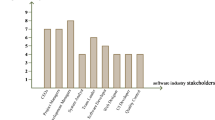Abstract
This exploratory study aims to gain insight into how usability practitioners work in professional web design. This is done through interviews and a grounded analysis. The description reported here refers to the wider influence of the commercial context on usability work. This brings to the fore such issues as the client’s influence on work, negotiation between clients and practitioners, the adaptation and use of methods, practitioner expertise and the consideration of people in the usability process. It is believed that this research focus, which moves toward wider issues in practice, is best conceptualized from a system level perspective where the goal is to coordinate resources to add value to the design process.
Access this chapter
Tax calculation will be finalised at checkout
Purchases are for personal use only
Preview
Unable to display preview. Download preview PDF.
Similar content being viewed by others
References
Bellotti, V. (1988). Implications of current design practice for the use of HCI techniques. Proceedings of the BCS HCI’88, Manchester, UK. 13–34.
Bellotti, V., Buckingham Shum, S., MacLean, A., & Hammond, N. (1995). Multidisciplinary modelling in HCI design, in theory and in practice. Proceedings of CHI 1995,Colorado, USA. 429–436.
Blandford, A., Buckingham Shum, S., & Young, R. (1998). Training software engineers in a novel usability evaluation technique. International Journal of Human-Computer Studies, 49, 245–279.
Buckingham Shum, S., & Hammond, N. (1994). Transferring HCI modelling and design techniques to practitioners: A framework and empirical work. Proceedings of BCS HCI’94 (pp. 21–36), Glasgow, UK
Card, S., Moran, T., & Newell, A. (1983). The psychology of human-computer interaction. Lawrence Erlbaum Associates.
Chase, W., & Simon, H. (1973). Perception in Chess. Cognitive Psychology, 4, 55–81.Cited in Mayer, E. (1997). From novice to expert. In Helander, M., Landauer, T., & Prabhu, P. (Eds.) (1997) Handbook of Human Computer Interaction (2nd Ed.) (pp. 781–797). Elsevier Science.
Cockton, G. (2004). Value-centred HCI. In Proceedings of NordiCHI ’04 (pp. 149–160), Tampere, Finland.
Dumas, J. S., Molich, R., & Jeffries, R. (2004). Describing usability problems: are we sending the right message? Interactions, 11, 4 (Jul. 2004), 24–29.
Grudin, J. (1990). The computer reaches out: the historical continuity of interface design. Proceedings of the SIGCHI Conference on Human Factors in Computing Systems: Empowering People (pp. 261–268). Seattle, Washington, USA.
Grudin, J., & Markus, M. (1997). Organizational issues in development and implementation of interactive systems. In Helander, M., Landauer, T., & Prabhu, P. (Eds.), Handbook of Human Computer Interaction (2nd Ed.) (pp. 1457–1474). Elsevier Science.
Hammond, N., Jørgensen, A., MacLean, A., Barnard, P., & Long, J. (1983). Design practice and interface usability: Evidence from interviews with designers. Proceedings of CHI’93 (pp. 40–44), Boston, Massachusetts, USA.
Hornbæk, K., & Frøkjær, E. (2005). Comparing usability problems and redesign proposals as input to practical systems development. Proceedings of CHI’05 (pp. 391–400). Portland, Oregon, USA.
Nørgaard, M., & Hornbæk, K. (2006). What do usability evaluators do in practice? An explorative study of think-aloud testing. Proceedings of DIS ’06 (pp. 209–218), University Park, PA, USA.
Klein, G. (1998). Sources of power: How people make decisions. Cambridge: MIT Press
O’Neill, E. (1998). User-developer cooperation in software development: building common ground and usable systems. PhD Thesis. Queen Mary, University of London.
Perry, M., Fruchter, R., & Rosenburg, D. (1999). Co-ordinating distributed knowledge: A study into the use of an organisational memory. Cognition, Technology and Work, 1, 142–152.
Piegorsch, K., Watkins, K., Piegorsch, W., Reininger, B., Corwin, S., & Valois, R. (2006). Ergonomic decision-making: A conceptual framework for experienced practitioners from backgrounds in industrial engineering and physical therapy. Applied Ergonomics, 37, 587–598.
Redish, J., Bias, R. G., Bailey, R., Molich, R., Dumas, J., & Spool, J. M. (2002). Usability in practice: formative usability evaluations – evolution and revolution. In CHI ’02 Extended Abstracts on Human Factors in Computing Systems (pp. 885–890), Minneapolis, Minnesota, USA.
Rosson, M., Maass, S., & Kellogg, W. (1988). The designer as user: Building requirements for the design tools from design practice. Communication of the ACM, 31(11), 1288–1298.
Strauss, A., & Corbin, J. (1998) Basics of qualitative research: Techniques and procedures for developing grounded theory (2nd ed.). Sage Publications.
Terrins-Rudge, D., & Jørgensen, A. (1993). Supporting the designers: reaching the user. In P.F. Byerley, P.J. Barnard and J. May (Eds.), Computers, communication and usability: design issues, research and methods for integrated services. Cited in O’Neill, E. (1998). User-developer cooperation in software development: building common ground and usable systems. PhD Thesis. Queen Mary, University of London. 23–66.
Author information
Authors and Affiliations
Editor information
Editors and Affiliations
Rights and permissions
Copyright information
© 2008 Springer-Verlag London Limited
About this chapter
Cite this chapter
Furniss, D., Blandford, A., Curzon, P. (2008). Usability Work in Professional Website Design: Insights from Practitioners’ Perspectives. In: Law, E.LC., Hvannberg, E.T., Cockton, G. (eds) Maturing Usability. Human-Computer Interaction Series. Springer, London. https://doi.org/10.1007/978-1-84628-941-5_7
Download citation
DOI: https://doi.org/10.1007/978-1-84628-941-5_7
Publisher Name: Springer, London
Print ISBN: 978-1-84628-940-8
Online ISBN: 978-1-84628-941-5
eBook Packages: Computer ScienceComputer Science (R0)




